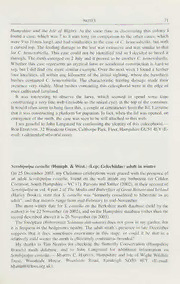
Scrobipalpa costella (Humph. & West.) (Lep: Gelechiidae) adult in winter PDF
Preview Scrobipalpa costella (Humph. & West.) (Lep: Gelechiidae) adult in winter
— NOTES 71 Hampshire and the Isle of Wight). At the same time as discovering this colony 1 mm found a case, which was 7 to 8 long (in comparison to the other cases, which were 9 to 1mm long), and had similarities to the case of C. hemerohiella but with 1 , a curved top. The feeding damage to the leaf was extensive and was similar to that for C. hemerohiella. This case could not be identified and so 1 decided to breed it through. The moth emerged on 2 July and it proved to be another C. hemerohiella. Whether this case represents an atypical form or accidental construction is hard to say, but 1 did find one more similar example. Over the next week 1 found a further four localities, all within one kilometre of the initial sighting, where the hawthorn bushes contained C. hemerohiella. The characteristic feeding damage made their presence very visible. Most bushes containing this coleophorid were at the edge of once cultivated farmland. It was interesting to observe the larva, which seemed to spend some time constructing a very fine web (invisible to the naked eye), at the top of the container. It would often seem to hang from this, a couple of centimetres from the lid. I assume that it was constructing a platform for pupation. In fact, when the lid was opened, on emergence of the moth, the case was seen to be still attached to this web. I am grateful to John Langmaid for confirming the identity of this coleophorid. Rob Edmunds, 32 Woodcote Green, Calthorpe Park, Fleet, Hampshire GU5 4EY (E- 1 mail: [email protected]). Scrobipalpa costella (Humph. & West.) (Lep: Gelechiidae) adult in winter On 25 December 2003, my Christmas celebrations were graced with the presence of an adult Scrobipalpa costella, found on the wall inside my bathroom (in Colden Common, South Hampshire - VC 1 1 ). Parsons and Sattler (2002), in their account of Scrobipalpa in vol. 4 part 2 of The Moths and Butterflies ofGreat Britain and Ireland (Harley Books), state that S. costella was “formerly considered to hibernate as an adult”, and that records range from mid-February to mid-November. The most wintry date for S. costella on the Berkshire moth database (held by the author) is for 22 November (in 2002), and on the Hampshire database (other than the record described above) it is 26 November (in 2003). The foodplant (Bittersweet Solanum dulcamara does not grow in my garden, but ) it is frequent in the hedgerows nearby. The adult moth's presence in late December suggests that it does sometimes overwinter in this stage, or could it be that in a relatively mild winter the moth is effectively continuous-brooded? My thanks to Tim Norriss for checking the Butterfly Conservation (Hampshire Branch) moth database, and to John Langmaid for additional information on — Scrobipalpa costella. Martin C. Harvey, Hampshire and Isle of Wight Wildlife Trust, Woodside House, Woodside Road, Eastleigh SO50 4ET. (E-mail: [email protected]).
